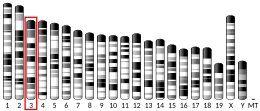DCLRE1B
DNA cross-link repair 1B protein is a protein that in humans is encoded by the DCLRE1B gene.[5]
DNA interstrand cross-links prevent strand separation, thereby physically blocking transcription, replication, and segregation of DNA. DCLRE1B is one of several evolutionarily conserved genes involved in repair of interstrand cross-links (Dronkert et al., 2000).[supplied by OMIM][5]
Function
[edit]The DCLRE1B/SNM1B/Apollo protein is a repair exonuclease that digests double-stranded and single-stranded DNA with a 5’ to 3’ directionality.[6]
Using an SNM1B/Apollo knockout mouse model, evidence was obtained that SNM1B/Apollo protein is required to protect telomeres against illegitimate non-homologous end joining that can result in genomic instability and consequently in multi-organ developmental failure.[7]
In a human patient with Hoyeraal-Hreidarsson syndrome, a dominant negative mutation in the SNM1B/Apollo gene was discovered.[8] This mutation hampered the proper replication of telomeres, leading to major telomeric dysfunction and cellular senescence. SNM1B/Apollo protein appears to be a crucial factor in telomere maintenance, independent of its function in repairing DNA inter-strand crosslinks.[8]
References
[edit]- ^ a b c GRCh38: Ensembl release 89: ENSG00000118655 – Ensembl, May 2017
- ^ a b c GRCm38: Ensembl release 89: ENSMUSG00000027845 – Ensembl, May 2017
- ^ "Human PubMed Reference:". National Center for Biotechnology Information, U.S. National Library of Medicine.
- ^ "Mouse PubMed Reference:". National Center for Biotechnology Information, U.S. National Library of Medicine.
- ^ a b "Entrez Gene: DCLRE1B DNA cross-link repair 1B (PSO2 homolog, S. cerevisiae)".
- ^ Sengerová B, Allerston CK, Abu M, Lee SY, Hartley J, Kiakos K, Schofield CJ, Hartley JA, Gileadi O, McHugh PJ (2012). "Characterization of the human SNM1A and SNM1B/Apollo DNA repair exonucleases". J. Biol. Chem. 287 (31): 26254–67. doi:10.1074/jbc.M112.367243. PMC 3406710. PMID 22692201.
- ^ Akhter S, Lam YC, Chang S, Legerski RJ (2010). "The telomeric protein SNM1B/Apollo is required for normal cell proliferation and embryonic development". Aging Cell. 9 (6): 1047–56. doi:10.1111/j.1474-9726.2010.00631.x. PMC 3719988. PMID 20854421.
- ^ a b Touzot F, Callebaut I, Soulier J, Gaillard L, Azerrad C, Durandy A, Fischer A, de Villartay JP, Revy P (2010). "Function of Apollo (SNM1B) at telomere highlighted by a splice variant identified in a patient with Hoyeraal-Hreidarsson syndrome". Proc. Natl. Acad. Sci. U.S.A. 107 (22): 10097–102. Bibcode:2010PNAS..10710097T. doi:10.1073/pnas.0914918107. PMC 2890423. PMID 20479256.
Further reading
[edit]- Strausberg RL, Feingold EA, Grouse LH, et al. (2003). "Generation and initial analysis of more than 15,000 full-length human and mouse cDNA sequences". Proc. Natl. Acad. Sci. U.S.A. 99 (26): 16899–903. Bibcode:2002PNAS...9916899M. doi:10.1073/pnas.242603899. PMC 139241. PMID 12477932.
- Ota T, Suzuki Y, Nishikawa T, et al. (2004). "Complete sequencing and characterization of 21,243 full-length human cDNAs". Nat. Genet. 36 (1): 40–5. doi:10.1038/ng1285. PMID 14702039.
- Demuth I, Digweed M, Concannon P (2004). "Human SNM1B is required for normal cellular response to both DNA interstrand crosslink-inducing agents and ionizing radiation". Oncogene. 23 (53): 8611–8. doi:10.1038/sj.onc.1207895. PMID 15467758. S2CID 10082205.
- Gerhard DS, Wagner L, Feingold EA, et al. (2004). "The status, quality, and expansion of the NIH full-length cDNA project: the Mammalian Gene Collection (MGC)". Genome Res. 14 (10B): 2121–7. doi:10.1101/gr.2596504. PMC 528928. PMID 15489334.
- Ishiai M, Kimura M, Namikoshi K, et al. (2004). "DNA cross-link repair protein SNM1A interacts with PIAS1 in nuclear focus formation". Mol. Cell. Biol. 24 (24): 10733–41. doi:10.1128/MCB.24.24.10733-10741.2004. PMC 533992. PMID 15572677.
- Freibaum BD, Counter CM (2006). "hSnm1B is a novel telomere-associated protein". J. Biol. Chem. 281 (22): 15033–6. doi:10.1074/jbc.C600038200. PMID 16606622.
- Gregory SG, Barlow KF, McLay KE, et al. (2006). "The DNA sequence and biological annotation of human chromosome 1". Nature. 441 (7091): 315–21. Bibcode:2006Natur.441..315G. doi:10.1038/nature04727. PMID 16710414.
- Lenain C, Bauwens S, Amiard S, et al. (2006). "The Apollo 5' exonuclease functions together with TRF2 to protect telomeres from DNA repair". Curr. Biol. 16 (13): 1303–10. Bibcode:2006CBio...16.1303L. doi:10.1016/j.cub.2006.05.021. PMID 16730175.
- van Overbeek M, de Lange T (2006). "Apollo, an Artemis-related nuclease, interacts with TRF2 and protects human telomeres in S phase". Curr. Biol. 16 (13): 1295–302. Bibcode:2006CBio...16.1295V. doi:10.1016/j.cub.2006.05.022. PMID 16730176. S2CID 121737.




